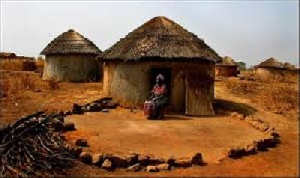- Home - News
- TWI News | TV
- Polls
- Year In Review
- News Archive
- Crime & Punishment
- Politics
- Regional
- Editorial
- Health
- Ghanaians Abroad
- Tabloid
- Africa
- Religion
- Election 2020
- Coronavirus
- News Videos | TV
- Photo Archives
- News Headlines
- Press Release
Opinions of Wednesday, 30 January 2013
Columnist: Commey, Gideon
The Accra Waste Math
“In the midst of the catastrophic pollution of the environment by humans, we have chosen to take a stand for and with the environment against humans”
If you are terrified by the sight of the disgusting pile of waste in the gutters, on the streets and inside every nook and cranny of Accra, then you probably don’t live in Ghana. The country has a severe environmental crisis and featuring prominently on that list is sanitation.
When we talk about sanitation in Ghana, the argument is mostly political, social and cultural (attitudinal), but to really grasp the seriousness of the mess, you have to do a simple math to create a powerful story. The Ghana Youth Environmental Movement (GYEM) is building a generation wide movement of young people to solve the environmental crisis in Ghana, and we have done a little math to tell the scale of the sanitation problem and offer a sustainable solution once and for all.
Our simple math has 3 numbers:
1. 2,500 tons
This is the amount of waste that is generated in Accra per day. Out of this number, 2,200 tons is collected and dumped at landfills, the remaining 300 tons find their way into open drains, streets, etc. Multiplying the amount of waste land filled by 365 days gives the total amount of waste Accra produces per year as 803,000 tons.
2. 10 Megawatts (MW)
Officials of the Accra Compost & Recycling Plant (ACRP), has indicated to the government that it is possible to use appropriate technology to produce 10MW of electricity out of 1,000 tons of waste per day. This amount of energy can power several thousands of households. To put this figure into perspective, two (2) waste-to-energy plants or a single one with combined capacity, with appropriate technology can swallow up all the waste Accra city produces in a day and still lack enough waste to power the plants. Simply put, we would run out of waste in the city.
Sweden runs the most effective and efficient waste management system in the world. The garbage generates 20% of the country’s district heating and provides electricity to 250,000 homes. “The only problem with the Sweden Waste Management system is that it is too successful”. The waste Sweden produces is just not enough that they import 800,000 tons of waste from their neighbors Norway to keep the plants running. The amount they import is nearly equivalent to the amount of waste Accra produces in a whole year.
3. US$ 150m
Waste-energy experts in Ghana indicate that this is roughly the amount of money that can fund the operation of a waste-energy plant with appropriate technology to produce 10MW- 12MW per hour using between 1,000-1,500 tons of municipal solid waste per day. These figures are not perfect but are highly reliable.
So why hasn’t it been done? The excuse the government and municipal waste management officials give is that there is no budget and funds for this. We at Ghana Youth Environmental Movement are saying that we can find that money through a Price for Pollution. (Read about our Price for Pollution solutions here-http://gideoncommey.blogspot.com/2013/01/what-is-price-for-pollution-why-you.html).
We just need the political will to do that. Yes, we can raise that money over here in Ghana. The solution is a Price for Pollution and it holds the keys to a green renewable future.
Every rapid transformational change requires a movement to drive it, our movement has just arrived and there’s only one thing on our mind – environmental power shift in Ghana.
Gideon Commey (Campaigns Team, Ghana Youth Environmental Movement). gyemgh@gmail.com










